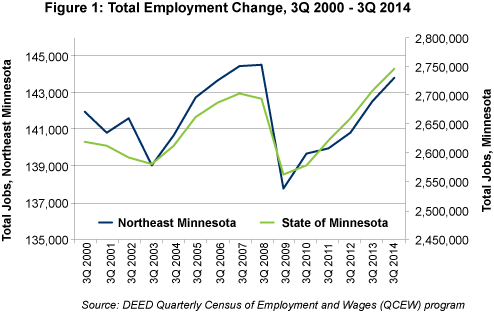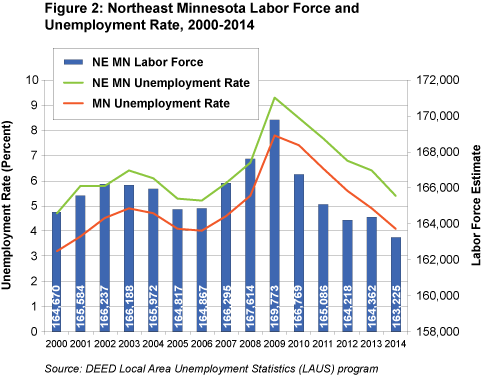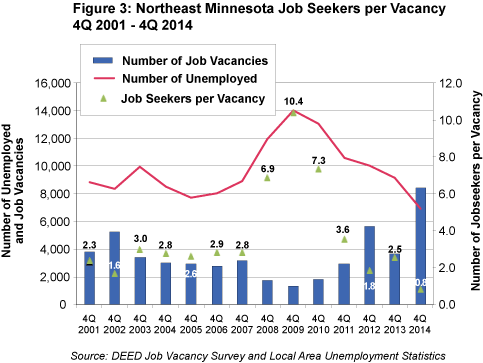
by Erik White
June 2015
The Northeast region is approaching full recovery, although job growth in that part of the state has been uneven.
 The seven-county Northeast Minnesota planning region was home to 8,767 businesses and 143,797 jobs as of the third quarter of 2014. That was about 5.2 percent of the total jobs in the state.
The seven-county Northeast Minnesota planning region was home to 8,767 businesses and 143,797 jobs as of the third quarter of 2014. That was about 5.2 percent of the total jobs in the state.
What makes Northeast Minnesota unusual is its high concentration of employment in mining, health care and social assistance, and leisure and hospitality. Nearly 70 percent of the state's 6,794 mining jobs are located in Northeast Minnesota. Health care and social assistance provides 22.3 percent of total employment in the planning region, compared with 16.6 percent statewide.
Lastly, because of Northeast Minnesota's lakes and wilderness, tourism-related and accommodation industries play an integral part in the regional economy, accounting for 14 percent of total employment.
Much like the rest of the state, Northeast's economy has encountered peaks and valleys during the last 15 years, with big recessionary declines and steady recoveries. In the recent recession, Northeast Minnesota dropped from 144,488 jobs in the third quarter of 2007 to 137,765 jobs in the third quarter of 2009. The region then climbed back to 143,797 jobs in 2014.
While Minnesota had recovered all the jobs lost in the Great Recession by the third quarter of 2013, Northeast still had about 700 jobs to go before reaching full recovery.
Northeast Minnesota enjoyed a strong start to the recovery, with a gain of 1,879 jobs from 2009 to 2010, a 1.4 percent increase. The region, however, endured a lull in job creation for the next two years, adding only 1,178 net new jobs from 2010 to 2012, an average annual growth rate of 0.4 percent.
The Northeast economy regained steam over the past two years, adding 1,707 jobs from 2012 to 2013 and 1,268 jobs from 2013 to 2014, an average of 1 percent growth each year (see Figure 1).

Sectors experienced the recession and recovery differently in Northeast Minnesota. All but one industry lost jobs from 2007 to 2009. Since then, 17 of the 20 industries have created jobs. Because of the recent growth, half of the region's industries have now regained their pre-recession employment levels.
Health care and social assistance is easily the largest industry in the region, having almost twice as many jobs as the next largest sector. The health care industry gained 1,124 jobs from third quarter 2007 to third quarter 2009. The sector continued to grow during the recovery, albeit at a slower rate, with 340 jobs added over the next five years.
As noted, 10 of the 20 major industries in the region now have more jobs than before the recession, with the biggest increases seen in mining, educational services, and professional, scientific and technical services. Other services, accommodation and food services, and public administration had all fully recovered as well.
In contrast, the recession hit the manufacturing industry hardest, with 2,290 jobs lost, accounting for more than one-third of all jobs cut in Northeast Minnesota during this span. Unfortunately, the recovery hasn't helped this sector much, with only 26 jobs added since 2009.
Other industries that have yet to regain their pre-recession employment include information, retail trade, and finance and insurance, which are all still short by a considerable amount (see Table 1).
| Northeast Minnesota Industry Employment Statistics, Q3 2007-Q3 2014 | ||||||
|---|---|---|---|---|---|---|
| NAICS Industry Title | Number of Jobs Q3 2014 | Number of Firms Q3 2014 | Quarterly Payroll Q3 2014 | Recession | Recovery | Total |
| Change in Jobs Q3 2007 - Q3 2009 | Change in Jobs Q3 2009 - Q3 2014 | Change in Jobs Q3 2007 - Q3 2014 | ||||
| Total, All Industries | 143,797 | 8,676 | $1,485,704,532 | -6,723 | 6,032 | -691 |
| Agriculture, Forestry, Fishing and Hunting | 598 | 128 | $5,627,772 | -154 | -29 | -183 |
| Mining | 4,650 | 30 | $104,418,630 | -1,246 | 2,058 | 812 |
| Construction | 7,774 | 959 | $108,562,258 | -578 | 877 | 299 |
| Manufacturing | 8,605 | 345 | $117,498,263 | -2,290 | 26 | -2,264 |
| Utilities | 1,785 | 55 | $39,715,145 | -2 | 120 | 118 |
| Wholesale Trade | 3,160 | 278 | $38,098,023 | -134 | 87 | -47 |
| Retail Trade | 17,923 | 1,383 | $105,593,441 | -1,198 | 474 | -724 |
| Transportation and Warehousing | 3,587 | 323 | $41,204,825 | -253 | 199 | -54 |
| Information | 1,652 | 148 | $17,490,967 | * | * | -924 |
| Finance and Insurance | 4,424 | 437 | $52,152,405 | -216 | -463 | -679 |
| Real Estate and Rental and Leasing | 1,386 | 267 | $9,026,856 | -27 | 127 | 100 |
| Professional, Scientific, and Tech | 4,234 | 554 | $60,805,269 | -27 | 475 | 448 |
| Management of Companies | 871 | 39 | $16,095,917 | -45 | -119 | -164 |
| Administrative and Support and Waste Mgmt. | 4,297 | 304 | $27,354,100 | -680 | 428 | -252 |
| Educational Services | 9,896 | 266 | $111,395,043 | -41 | 618 | 577 |
| Health Care and Social Assistance | 32,700 | 878 | $387,887,217 | 1,124 | 360 | 1,484 |
| Arts, Entertainment, and Recreation | 4,156 | 238 | $22,938,821 | * | 100 | * |
| Accommodation and Food Services | 16,137 | 933 | $60,132,278 | -290 | 543 | 253 |
| Other Services (except Public Administration) | 4,881 | 781 | $30,368,891 | -127 | 423 | 296 |
| Public Administration | 11,075 | 330 | $129,338,411 | -56 | 260 | 204 |
| Source: DEED's Quarterly Census of Employment and Wages (QCEW) Program | ||||||
The labor force and unemployment rates in Northeast Minnesota have expanded and contracted in relation to the recession and recovery. In 2009, the region's unemployment rate reached its highest point at 9.3 percent, while the labor force ballooned to 169,773 workers as people responded to the recession by entering the job market to supplement incomes. Since then, those workers have gradually dropped out, prompting unemployment rates to fall to 5.4 percent, similar to the region's unemployment rates before the recession.
The region's labor force was down to 163,225 workers in 2014, a decline of 6,548 from the peak in 2009 and a decline of 1,245 people from 2000. Northeast Minnesota's unemployment rate has been higher than the state every year since 2000, averaging 1.3 percentage points above the state rate over the last 15 years.
Despite their difference in magnitude, the region's unemployment rates have followed the same trend as the state. Minnesota's labor force, however, has continued to grow throughout the recovery period, while the labor force in Northeast Minnesota has decreased (see Figure 2).

As the labor force has declined and the economy continues to recover, the region's labor market has tightened. One clear demonstration of this is the ratio of unemployed job seekers per vacancy, which now stands at less than 1-to-1 in Northeast Minnesota.
According to DEED's Job Vacancy Survey from the fourth quarter of 2014, there were 8,410 job vacancies reported by employers and an average of 6,923 unemployed job seekers in the region. The number of job seekers per vacancy climbed to as high as 10.4 during the recession in 2009, but then steadily decreased before dropping below one job seeker per vacancy in 2014 (see Figure 3).

The recession had a great impact on Northeast Minnesota's economy, with all but one industry sector losing jobs. The region's economy, however, has gained momentum since then and is quickly approaching full recovery, even though job change has been uneven across industries. Health care delivered recession-proof employment growth, while manufacturing lost many jobs and has yet to begin its road to recovery.
In a reversal of the job environment just five years ago, current vacancies show an extreme tightening of the labor market, with more job postings than available workers. Employers in the region will have to compete for job seekers to continue growing.